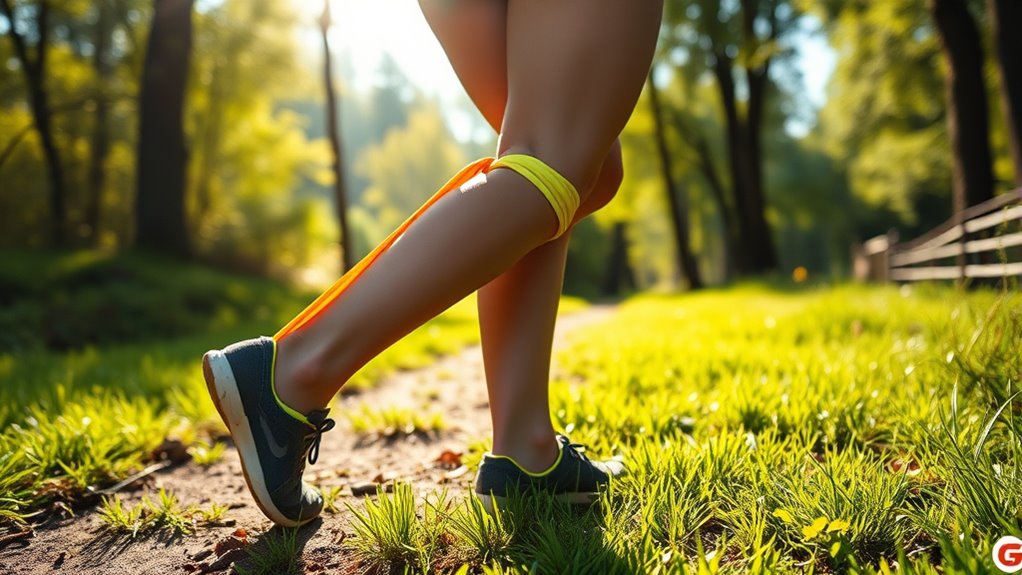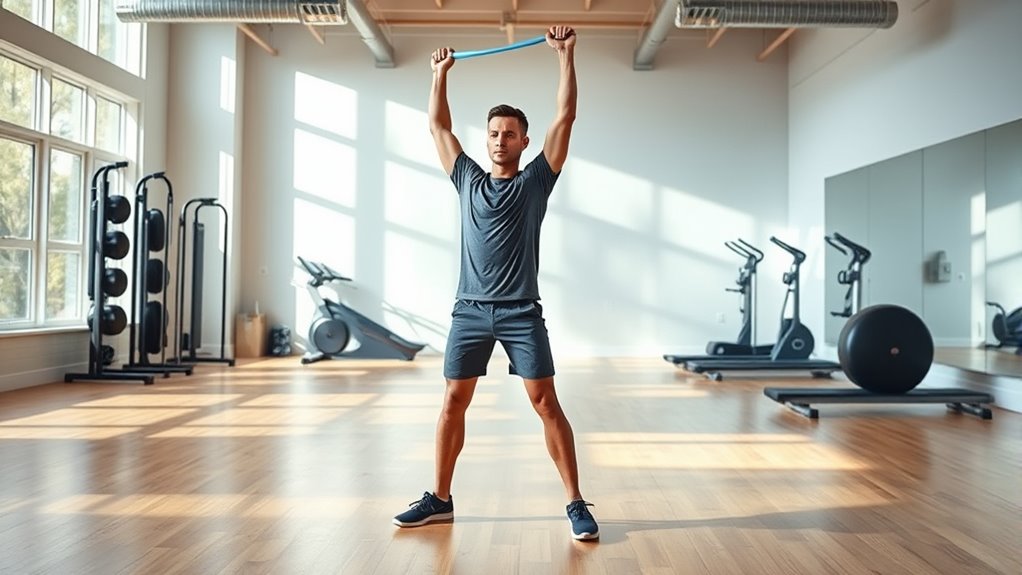Before you walk, using stretch bands for warm-ups can boost your flexibility, reduce injury risk, and improve movement efficiency. Focus on exercises targeting your leg muscles, like hamstring and calf stretches, and include upper-body movements to loosen your shoulders and chest. Keep your stretches controlled and comfortable, and hold each for 15-30 seconds. Incorporating these routines will help you move better and feel more prepared—continue on to discover the best techniques and exercises.
Key Takeaways
- Use stretch bands to target key muscles like hamstrings, calves, hips, and quadriceps for improved flexibility before walking.
- Perform controlled stretches such as hamstring pulls, hip abductions, and calf raises with bands to warm up muscles effectively.
- Incorporate upper-body stretches with bands, including shoulder rolls and chest expansions, to enhance overall mobility.
- Ensure proper resistance and technique, holding each stretch for 15-30 seconds for optimal benefits and injury prevention.
- Complete the routine with light movements and deep breathing to activate muscles and prepare your body for walking.
Benefits of Incorporating Stretch Bands Into Your Warm-Up

Incorporating stretch bands into your warm-up can substantially enhance your flexibility and prepare your muscles for activity. Improved flexibility offers several benefits, including better movement efficiency and a greater range of motion, which makes walking more comfortable. Additionally, stretching with bands helps loosen tight muscles and tendons, reducing strain during exercise. One of the key advantages of injury prevention is that flexible muscles are less prone to strains, tears, and other injuries. Using stretch bands allows you to target specific muscle groups effectively, ensuring your body is ready for the demands of walking. By making band-assisted stretching part of your routine, you set a solid foundation for a safer, more enjoyable walk, while also supporting your overall mobility and longevity. Regularly monitoring your progress can help optimize your stretching routine and prevent overexertion.
Key Stretch-Band Exercises to Prepare Your Legs

To effectively prepare your legs for walking, focus on key stretch-band exercises that target major muscle groups. These exercises improve leg flexibility and hip mobility, essential for a smooth walk. Start with:
- Leg swings: Hold the band around your ankle and swing your leg forward and backward. This enhances leg flexibility and warms up hip joints.
- Hip abductions: Attach the band around your thighs, then move your leg outward to open your hips. This boosts hip mobility and strengthens outer hip muscles.
- Seated hamstring stretch: Sit with the band around your foot and gently pull your leg toward you. This stretch improves hamstring flexibility, reducing injury risk.
Consistently performing these exercises prepares your legs for walking while promoting better movement and reduced stiffness.
Upper Body Stretch-Band Movements to Loosen Up

Start your warm-up with shoulder rolls and stretches to release tension. Incorporate arm circles to improve your shoulder flexibility and prepare your arms for movement. Finish with chest expansion techniques to open up your upper body and boost your overall mobility. Also, consider incorporating emotional readiness into your routine to ensure a comfortable and confident workout experience.
Shoulder Rolls and Stretches
Shoulder rolls and stretches are effective ways to loosen up your upper body before walking. They help improve posture correction and reduce injury risk. To get started:
- Roll your shoulders forward in slow, controlled circles, feeling the tension melt away.
- Switch directions and roll them backward, focusing on a full range of motion.
- Use a stretch band to gently pull your arms overhead or across your chest, enhancing flexibility and loosening tight muscles.
- Incorporating dynamic warm-up techniques like shoulder mobility exercises can further prepare your muscles for activity.
These movements warm up your shoulder muscles, promote better posture, and prevent strain during walking. Incorporate these simple steps into your warm-up routine to stay injury-free and walk with confidence. Regular shoulder mobility exercises improve overall upper body function, making your walks more comfortable and effective.
Arm Circles for Flexibility
Arm circles are an effective way to enhance shoulder mobility and prepare your upper body for walking. By performing controlled arm circles, you loosen tight muscles and increase flexibility in your shoulders. Stand tall with your arms extended out to the sides. Slowly rotate your arms in small circles, gradually enlarging the movement as your muscles loosen. Focus on smooth, steady motions to avoid strain. As you progress, reverse the direction of the circles to ensure balanced shoulder mobility. This simple movement warms up your shoulder joints, reduces stiffness, and improves range of motion. Incorporating arm circles into your warm-up routine helps prevent injuries and boosts overall upper body flexibility, setting a solid foundation for an effective walk.
Chest Expansion Techniques
Using a stretch band to perform chest expansion exercises effectively loosens up the upper body muscles and improves posture before your walk. These movements help enhance posture alignment and promote better breathing techniques. To do this:
- Stand tall, hold the band with both hands wide apart, and gently pull it apart while keeping your arms straight. Focus on opening your chest and engaging your back muscles.
- Slowly raise the band overhead, keeping your shoulders relaxed, and then lower it behind your back. This stretch opens the chest and encourages deep, controlled breaths.
- Pull the band across your chest, keeping your elbows slightly bent, to stretch the pectoral muscles. Breathe deeply as you hold each position, reinforcing posture and breathing benefits.
- Incorporating these exercises regularly can also help improve posture alignment, making your walking experience more comfortable and effective.
These simple steps prepare your upper body for a more efficient walk.
How to Properly Use Stretch Bands for Warm-Up

Choosing the right stretch band is key to a safe warm-up, so pick one with the appropriate resistance for your strength level. Once you have your band, focus on performing stretches that target your muscles effectively without overstretching. Proper technique helps you get the most benefit and reduces the risk of injury. Additionally, incorporating proper air quality awareness during your warm-up can enhance breathing and overall performance.
Selecting the Right Band
Selecting the right stretch band is essential to guarantee a safe and effective warm-up. First, consider band resistance; choose a band with resistance that matches your strength level to prevent overstretching or insufficient tension. Second, focus on material selection—opt for durable, skin-friendly materials like natural rubber or latex that won’t snap or cause irritation. Third, assess the band’s length and width; a longer, wider band provides more control and flexibility during your warm-up. Picking the appropriate resistance ensures you engage muscles safely, while quality materials promote longevity and comfort. Additionally, selecting a band made from natural materials can help reduce skin irritation and improve durability. By paying attention to these factors, you’ll maximize the effectiveness of your warm-up and reduce injury risk. Remember, the right band makes all the difference in your preparation routine.
Performing Effective Stretches
To perform effective stretches with a resistance band, it’s important to focus on controlled movements that target major muscle groups. Use proper stretching techniques to avoid injury and maximize flexibility. Keep each stretch steady, holding for about 15-30 seconds, and avoid bouncing. The warm-up duration should be long enough to increase blood flow without fatiguing muscles. Incorporate a variety of stretches to cover your hamstrings, quadriceps, calves, and shoulders. Here’s a quick guide:
| Muscle Group | Stretching Technique | Duration |
|---|---|---|
| Hamstrings | Sit and gently pull the band towards you | 15-30 sec |
| Quads | Stand and pull the band around your ankle | 15-30 sec |
| Calves | Step on the band and stretch your heel downward | 15-30 sec |
| Shoulders | Pull the band across your chest | 15-30 sec |
Creating a Quick and Effective Stretch-Band Routine

Creating a quick and effective stretch-band routine starts with focusing on key muscle groups you’ll use during your walk. First, choose a band with appropriate tension—neither too tight nor too loose—to guarantee controlled movement. Next, perform each stretch for about 15-30 seconds, maintaining consistent stretch duration to prevent overstretching or injury. Finally, follow these steps:
- Target your hamstrings and calves with gentle pulls, adjusting band tension for comfort.
- Move to your hips and quadriceps, using controlled motions to activate these muscles.
- Finish with light upper-body stretches, ensuring smooth, deliberate movements to optimize warm-up.
- Remember to keep your headphones properly adjusted if you plan to listen to music during your warm-up or walk, ensuring a comfortable experience.
This approach keeps the routine short, effective, and safe, helping you prepare without wasting time.
Tips for Maximizing Your Walking Performance With Warm-Ups

A well-designed warm-up routine sets the stage for a more productive walk by preparing your muscles and boosting circulation. To maximize your performance, focus on breathing techniques—inhale deeply through your nose and exhale slowly to oxygenate your muscles and reduce tension. Incorporate hydration strategies by drinking water before and after your warm-up to stay properly hydrated, which helps prevent fatigue and cramps. Gentle dynamic movements combined with breathing exercises can enhance flexibility and mental focus. Avoid rushing through your warm-up; instead, take your time to activate your muscles gradually. These tips ensure your body is ready, reducing injury risk and improving endurance during your walk. Additionally, paying attention to style and technique can help improve your walking efficiency and prevent strain. Consistent preparation ultimately leads to a more enjoyable and effective walking session.
Frequently Asked Questions
Can Stretch Bands Help Prevent Walking Injuries?
Using resistance training with stretch bands can help prevent walking injuries by promoting muscle activation. When you incorporate resistance bands into your warm-up, you activate key muscles, improving their strength and flexibility. This preparation reduces the risk of strains and overuse injuries during your walk. By engaging your muscles beforehand, you enhance stability and support, making your walking experience safer and more comfortable.
How Long Should a Stretch-Band Warm-Up Last?
Imagine your muscles are a bow, ready to shoot. The warm-up duration with a stretch band should be like gently pulling the bowstring, about 5 to 10 minutes. Keep band tension moderate to avoid overstretching. This guarantees your muscles warm up gradually, increasing flexibility and reducing injury risk. Consistent, mindful warm-ups help you walk confidently, just like a well-drawn bow ready to release its arrow smoothly.
Are Stretch Bands Suitable for All Fitness Levels?
You might wonder if stretch bands suit all fitness levels. They’re beginner-friendly and versatile, making them ideal whether you’re just starting or more experienced. The resistance variety allows you to customize workouts, gradually increasing intensity as you progress. This adaptability makes stretch bands a safe and effective choice for everyone, helping you build strength and flexibility without overexertion. So, yes, stretch bands are suitable for all fitness levels.
When Is the Best Time to Do Stretch-Band Warm-Ups?
Imagine the early morning sun casting a gentle glow as you prepare to step outside. The best time for your stretch-band warm-up is just before your walk, after a quick set of dynamic stretches. This primes your muscles, increases circulation, and prepares your body for activity. Incorporate warm-up routines with stretch bands to maximize flexibility and reduce injury risk, ensuring a smoother, more enjoyable walk ahead.
Do Stretch Bands Replace Traditional Stretching Methods?
You might wonder if stretch bands replace traditional flexibility routines. While stretch bands effectively improve muscle elasticity and can enhance your range of motion, they shouldn’t completely replace traditional stretching. Instead, combine both methods for maximum results. Stretch bands add resistance and target specific muscles, complementing static or dynamic stretches. This balanced approach ensures your muscles stay flexible, reduce injury risk, and support overall movement efficiency.
Conclusion
As you tighten the stretch band and feel the gentle resistance, imagine your muscles awakening, ready to propel you forward. With each warm-up move, you’re fueling your body’s engine, preparing it to glide smoothly along your walking route. Embrace this simple routine, and watch as your stride becomes more confident and effortless. Before you step out, remember—your warm-up is the key to a brighter, more energized walk, transforming a routine into a revitalizing experience.









